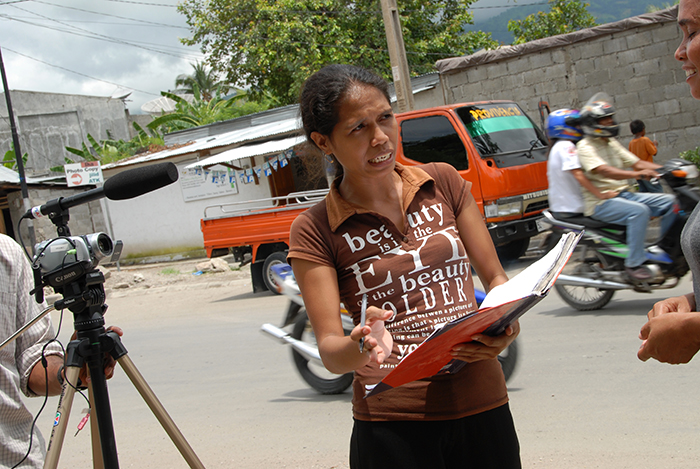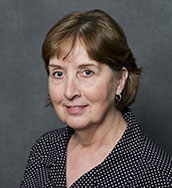Website features stories of female journalists who cover violence

LAWRENCE — Journalists write about post-traumatic stress disorder, especially as it relates to combat veterans, on a regular basis. But few stop to think that those same journalists covering conflicts and violence around the world may be suffering from post-traumatic stress of their own. A University of Kansas faculty member has completed a project in which she interviewed female journalists who cover all forms of violence and its multitude of effects.
 Barbara Barnett, the Lee F. Young Professor of Journalism, interviewed 35 women who covered wars, poverty, crime and courts, mass shootings or other forms of violence. She then published their stories, advice and how covering violence affected them personally, professionally and spiritually. The project, a “labor of love” for Barnett, started with the intent of publishing an academic journal article. As she worked with the journalists, she decided to make it available publicly after interviewing and writing for two years.
Barbara Barnett, the Lee F. Young Professor of Journalism, interviewed 35 women who covered wars, poverty, crime and courts, mass shootings or other forms of violence. She then published their stories, advice and how covering violence affected them personally, professionally and spiritually. The project, a “labor of love” for Barnett, started with the intent of publishing an academic journal article. As she worked with the journalists, she decided to make it available publicly after interviewing and writing for two years.
“I finally decided to just create my own site, where if anybody wanted it, they could find it. A lot of these people are journalists without access to an academic library,” Barnett said. “I also wanted them to be able to share it with other women and journalists.”
The interview subjects worked in Uganda, Congo, Afghanistan, Belgium and across the United States, among other areas. As they shared their stories with Barnett, the project took shape.
“I thought, ‘Oh my gosh, these people have seen so much,’” Barnett said. “Then, as I got further into it, I realized they had so much more to share. I let them define violence and started seeing just how many ways there are that journalists cover violence.”
Barnett’s site shares the women’s stories in a 12-part series. It examines their roles and location, what they learned from covering violence, how being female matters when covering violence, if it affected their careers positively or negatively, if it affected their religious faith, emotional and physical tolls, and why they choose to do the job.
As for their emotional and physical health, all respondents had been adversely affected. Four reported they had been sexually assaulted, several had been physically assaulted, and nearly all had experienced insomnia, hypervigilance and other telltale symptoms of post-traumatic stress. Fortunately, many said their conditions had improved with time. On a more negative note, many said they were still living not only with post-traumatic stress but continued threats on their lives because of their work.
“Some said, ‘I’ve never told my family these things, so please don’t use my name,’ and I respect that,” Barnett said. “One said, ‘Terrorists will kill me if they know where I am.’ I don’t think any of them just went into a situation, covered it and left — they all were part of it. People don’t often think of journalists as getting post-traumatic stress disorder because they’re supposed to be tough. Or that you can’t get it from just witnessing violence. Increasingly, there are studies that show there’s something called secondary stress and people can be affected by witnessing violence.”
The journalists shared what they learned from seeing war and murder on a practical, survival level. They give tips for everything from carrying extra batteries to wearing flat shoes in case they have to run. Several reported that dealing with trauma victims taught them to be better journalists, ask more insightful questions and that being empathetic was more important than getting a story. They also noted that empathy naturally led to more engaging stories that gave a better picture of the true experience of victims of trauma.
In terms of dealing with their own trauma, talking about it with supportive family members and colleagues was most helpful, several reported. The stress was simply too much for some of the journalists, as they said they couldn’t continue to witness trauma. Some reported that they changed beats, left journalism or felt that they couldn’t be a mother and witness violence against children as part of their work.
“Once the story is filed . . . my mind plays those events, and at times, this does not stop. The pain, the terror and powerless takes hold of me for days,” a Pakistani journalist told Barnett. “In all these events, there were many casualties. I saw injured people waiting long hours for someone to tend them. I stayed by dead bodies for someone to come and recognize them as their family or friends. I saw how morgues became short of space when hundreds of people were dead after bomb blasts and target killings. The coverage of these events left me a different person.”
Experiences varied as to whether covering violence benefited the journalists professionally. One journalist had covered virtually every mass shooting in the United States over the past several years, including the Pulse nightclub shooting in Orlando, Florida. Covering such events had given her work more prominence and career a boost, she said, but also carried with it guilt of being successful by writing about tragedy. As for why they covered violence, the reasons were many, but several reported they were natives of nations experiencing violence and it was vitally important to them to tell the stories of the victims of war, conflict, political violence and other types of trauma, and to help the world understand what was happening in their homes.
Covering violence had effects beyond the physical. Some journalists said it strengthened their faith, while others said it convinced them that no benevolent deity could allow such trauma to befall good people. In some cases, it didn’t change their faith at all. But all had one thing in common.
“Even those who didn’t believe in God believed in the goodness of humanity,” Barnett said.
Growing up in a military family, Barnett witnessed her father’s struggles with post-traumatic stress from his experiences in the Marine Corps. In her career as a journalist and professor, she’d seen firsthand violence and how it affects those who experience and cover it. The project was born out of a 2012 conference she took part in discussing post-traumatic stress with military and media members. The military has made progress in recent years in diagnosing and treating post-traumatic stress disorder for its members, but Barnett learned media is behind in that respect. The project was a way she could help journalists share their stories and find help.
“A lot of the journalists I met were just lost,” Barnett said. “There’s no one to help the media. I thought, ‘I’d like to do something that deals with journalists and their experiences. I’d always written about women as victims or perpetrators of violence, but what about the women who cover violence?”
A journalist at work in East Timor. Photo credit: Wikimedia.com